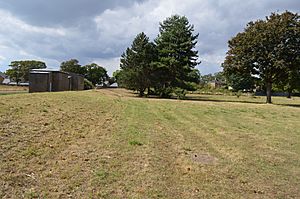Danish Camp facts for kids
The Danish Camp is an ancient fort in Shoeburyness, Essex, England. It was built long, long ago during the Iron Age. Today, it's a special protected site, like an important historical landmark. You can find it inside the Gunners Park and Shoebury Ranges nature reserve, which is looked after by the Essex Wildlife Trust.
Contents
What is the Danish Camp?
This ancient site is known as a 'slight univallate hillfort'. This means it was a fortified settlement, likely a village, with one main defensive wall or bank. It was built to protect the people living there.
What Remains Today?
Today, you can still see parts of the old defensive banks.
- The north-western part is about 80 metres long. It stands about 2 metres high and is 11 metres wide.
- The southern part is a little bit lower.
- There was also a ditch outside the banks, but it's mostly buried now.
Discoveries from the Past
Archaeologists have found many interesting things at the Danish Camp:
- Pottery: They found pieces of pottery from the Middle Iron Age, which was around 400 to 200 years before the Common Era (BCE).
- Homes: They also found signs of four round houses. These were the homes where people lived.
- Other Features: Many post holes and pits were also discovered. These show where wooden posts stood or where people dug holes for different purposes.
There are also some hints that people might have been in the area even earlier, during the Mesolithic (Middle Stone Age) and Bronze Age. However, these older signs are spread out, suggesting people used the general area, not just this specific fort site.
Why is it Called the Danish Camp?
The site is called the Danish Camp because people once thought it was built by a famous Viking leader named Hastein. The Anglo-Saxon Chronicle, an old historical record, says that Haesten built a fort in Shoebury in the year 894.
However, there is no actual evidence that Vikings ever lived at this particular site. The fort was built much earlier, during the Iron Age, long before the Vikings arrived in England. So, the name is a bit misleading!
Protecting the Past
The Danish Camp is a Scheduled Monument. This means it's a very important historical site that is protected by law. The government wants to make sure these ancient places are preserved for future generations to learn from.
The land around the camp was used for farming until 1849. Some parts of the Iron Age fort might have been lost when the land was changed for farming. Also, over time, parts of the site have been lost due to coastal erosion, where the sea slowly wears away the land. There's even some evidence that people from the Roman Empire lived in the south-west corner of the site later on.
Visiting the Danish Camp
You can visit the Danish Camp! It's open to the public and is located between Ness Road and Warrior Square Road in Shoeburyness. It's a great place to imagine what life was like thousands of years ago.


